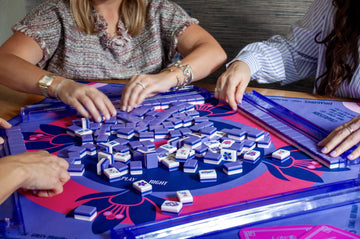Introduction:
American Mahjong, a timeless game steeped in tradition, has been a source of entertainment and camaraderie for generations. While many enthusiasts appreciate the game's rich history and strategic depth, there's always room for a bit of spontaneity and excitement. Who says you can't inject a dose of innovation into the world of Mahjong?
In this blog post, we're set to explore three unconventional variations of American Mahjong that break free from the conventional norms. Say goodbye to the familiar routine and embrace the thrill of Messy Mahjong, the challenge of Stacks/Towers, and the strategic anticipation of Futures. These unique twists promise to breathe new life into your Mahjong sessions, providing players with quick and dynamic alternatives that add an element of surprise to every move. So, let's dive into the world of unconventional Mahjong and discover how these variations can transform your gaming experience.
Messy Mahjong: Quick and Casual
Messy Mahjong is the go-to option when time is of the essence. Skip the formalities of building walls and dealing tiles. Instead, dump the tiles out onto your mat, flip all the tiles face-down, give them a nice good shuffle, and begin randomly grabbing your tiles. The dealer takes 14 and all other opponents grab 13. Once all players have their tiles, it’s normal gameplay from there on. All players still do the Charleston, because as experienced players know, the Charleston speeds up gameplay as this is the first opportunity to better your hand. The game begins when East discards one tile and play resumes to the right. With a focus on speed and simplicity, Messy Mahjong is the perfect choice for a quick game before running errands or picking up the kids from carpool.
Stacks/Towers: A Twist on Tradition
Stacks/Towers adds a unique spin to the game, reminiscent of the "Charleston with Bob" rule but on a grand scale. Set up begins with Messy Mahjong, meaning all tiles are dumped onto the mat randomly and turned face-side down. After a good shuffle while all tiles are turned over, each player randomly takes 13 tiles, 14 tilles if Dealer.
Once players have racked their tiles, each player randomly draws MORE tiles to place in front of their rack. You do NOT look at these tiles. Instead, create seven stacks of three; these are your “stacks” or “towers” that sit in front of your rack. The Charleston is then performed with the stacks directly in front of each player. Start by discarding three unwanted tiles from your hand and place them randomly into the middle of the mat face-down. Then grab one of your towers. The 3 tiles drawn from this stack or tower are now your tiles. Then, pick 3 more unwanted tiles and place into middle of mat face-side down. Grab the next tower. Once again, these are your tiles. Continue discarding 3 tiles at a time and drawing the next tower. There are slight variations depending on house rules such as: you can blind pass on the 3rd and 6th tower and some house rules allow a player to “stop the Charleston” after the 3rd tower whereas others make you play through ALL of the towers. You can decide what exact rules your house wants to play! This variation introduces an element of strategy as players navigate through the chaos of the stacks, making getting a joker in the Charleston a possibility!
Futures: A Mind-Bending Experience
Futures is a mind-bending variation that adds an extra layer of complexity to the game. Players start with 13 tiles in their rack and receive an additional "future" tile from the dealer, placed facing them on the exposure ledge. The catch? You can't add the future to your rack until it's your turn. Gameplay involves discarding, moving your future into your hand, and ending your turn by drawing a new future. Calling a tile prompts an exchange of futures among players, creating a dynamic and strategic element to the game. What do you do when someone calls a tile? Everyone exchanges their futures. So if East calls a tile, the person that played that tile will give East that tile that they played- WITH their future that is in their exposure rack face down, then everyone will exchange futures with the person to the right of them or across from them depending on who threw the wanted tile. So now, the futures have moved. Which is crummy- when you saw that it was a joker or a tile you needed, but have to give it up.
The exchange of futures adds an intriguing twist, forcing players to weigh the benefits of calling a tile against the potential loss of a valuable future. It's a game-changer that keeps everyone on their toes and injects a fresh sense of unpredictability into each round.
Conclusion:
American Mahjong is a game rich in tradition, but that doesn't mean you can't experiment with new ways to play. Messy Mahjong, Stacks/Towers, and Futures offer unique twists that cater to different preferences and time constraints. Whether you're a Mahjong enthusiast looking for a quick game or a seasoned player seeking a fresh challenge, these variations add spice to the classic game, making each round a delightful and unpredictable experience. So, gather your Mahjong group, try out these unconventional twists, and enjoy the thrill of a Mahjong game like never before!
If you would like to learn these variations, please feel free to contact the fabulous ladies from Dallas Mahj Club in Dallas, Texas. Dallas Mahj Club is an organization run by Ashley Gomez and Linda Casey, whose goal is to get as many mahjer’s into the game as possible. You can visit their Instagram: @DallasMahjClub or you can shoot them an email to: dmc@dallasmahjclub.com. They are official Oh My Mahjong instructors and will keep you on your toes teaching you all of the variations of American Mahjong!

Happy Mahj-ing! From the Mahj ladies at Dallas Mahj Club- Ashley Gomez & Linda Casey
